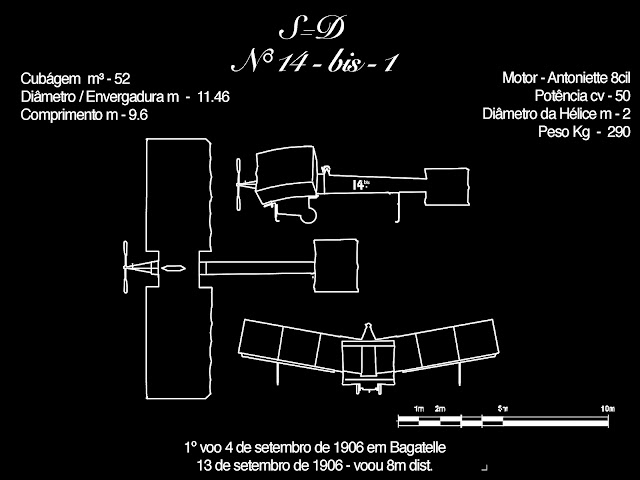The 14 Bis, the first
homologated airplane flight in history, emerged from a series of inventions
with the name "Number 14", learn how this series of events brought
the most famous airplane of Santos=Dumont.
Leia este artigo em Português
On June 12, 1905 Santos=Dumont flied his dirigible of number 14 in Saint-Cloud, it was an agile and fast model. With an internal volume of 200 cubic meters, the number 14 was extremely thin, moved by a Clement motor of 3.5 HP.
On June 12, 1905 Santos=Dumont flied his dirigible of number 14 in Saint-Cloud, it was an agile and fast model. With an internal volume of 200 cubic meters, the number 14 was extremely thin, moved by a Clement motor of 3.5 HP.
After the first tests
the dirigible proved to be extremely difficult to maneuver and very unstable.
Santos=Dumont has redesigned the involucre, this time more thick, with 186
cubic meters. He flew with this latest version of number 14 on August 21, 1905
on Trouville, in the coast.
It was also on the
French coast that Dumont noticed in a boats race that the Antoinette engines
were more powerful and lighter, which would make the flight of airplanes
possible.
Also in Trouville, he saw
the flight of kites in the shape of Hargraves cells and got inspired. His team
worked in secret. With a wingspan of 12 meters and measuring 10 meters long,
the bamboo frame was covered with Japanese silk, the rudder was projected in
front of the aircraft (canard configuration).
Santos=Dumont decided not
to take unnecessary risks, he knew he would had to master the commands before
venturing into the air, he decided to engage the aircraft dirigible of number
14 (that’s why it’s called 14 “bis” – Latin word bis means twice, repetition)
using a 24 HP Antoinette engine, the fusion of airplane and airship proved to
be extremely unstable, in addition its drag created was very great. See
animation below.
Click on the image
above to see how the airplane 14 a blimp in conjunction with number 14 was
unstable.
Once he got rid of the
dirigible, the biplane finally freed from its weak partner, received the name
of the press “Oiseau de Proie” (Bird of Prey).
Still aiming to master
the controls and find the best conditions for handling S=D ties cables to the
14 bis, that were pulled to the higher side with the help of a charming donkey
and then ran free, like a great zip line.
He also made some
experiments in the hangar and noticed that his engine would not able to take
flight, thus decided to replace it by a 50 HP Antoinette.
He realized this dream on September 4, 1906, when he flew for the first time in his plane number 14-Bis. It was small flights of 7 to 8 meters in the Campo de Bagatelle, but perhaps the happiest day of his life, as he finally managed to take off, with enough force to stay in the air.
Upon realizing that he needed the bearing axle (as we saw there arthras), he put ailerons on the tip of each wing.
It was in the field of
Bagatelle, on September 7 that S=D managed to get the wheels off the ground for
a little while, so that was how Dumont decided to put his trust on the 14 bis
to win the Archdeacon Prize.
He tried the flight
again on September 13, 1906 but the engine was not working with all pistons. His
technician, Chapin 14 fix it and he flew the incredible distance of 13 meters.
On October 23, 1906,
Santos Dumont presented himself again at Bagatelle with the Oiseau de Proie of
Oiseau II, with some small modifications on the original model, the airplane
had been varnished to reduce the porosity of the tissue and increase the lift.
At this day the 14 Bis
flew 60 meters at 3 meters high. But it was only on November 12, 1906 at 16:45 precisely
that the 14 Bis flew 220m at 6 meters high and won the prize offered by the Aeroclub
of France - IT WAS THE FIRST DOCUMENTED FLIGHT IN THE HISTORY OF AVIATION.










